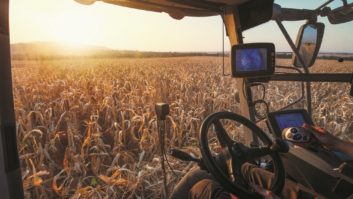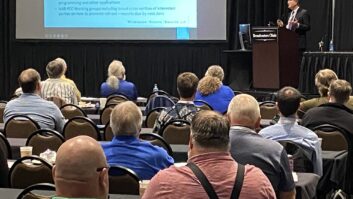‘Rural Lifestylers’ Help Energize This Specialized Niche of Radio Providers
Farm broadcasting is a tough row to hoe these days. Consolidation of agribusinesses, family farms and radio stations resulted in a shrinking advertising and listener base, leaving general managers to defend their programming to corporate owners who may not care about farm reports.
“The corporate radio mindset in some cases is that farming is a declining aspect of our business and not worth messing with,” said Gene Exline, general manager KFEQ(AM), which airs on 680 kHz in St. Joseph, Mo.
Michelle Rook, president of the National Association of Farm Broadcasting, acknowledges that farm broadcasters are facing challenges.
“But I think we as an industry are turning those challenges into opportunities. The growth of the rural lifestyle market is offering farm broadcasters options to increase revenues and listener base,” she said.
“Rural dwellers” are those living on three or more acres in a rural area outside the limits of a city or town. They gross less than $40,000 in sales from agriculture production. They may have livestock and do some planting but are not full-time farmers.
“This audience and market sector is estimated at anywhere between 4 to 20 million people,” said Rook. U.S. Census figures show rural lifestyle farms increased between 6.7 percent and 11.1 percent from 1997 to 2002 in four states studied: Minnesota, Wisconsin, Illinois and Georgia.
Country rules
At a meeting in the fall, NAFB released the results of its 2005 Rural Lifestyle Farms Research Study. The survey set out to identify what rural dwellers listen to and what they buy.
“This is a group that is hard to identify because they cover a wide spectrum of income and avocation to farming,” said Gene Millard, NAFB marketing consultant and overseer of the survey. Some may be living the rural lifestyle on a low income, others are professionals who have moved their families to the farm and commute to jobs in the city.
NAFB commissioned Ag Marketing Research of Sioux Falls, S.D., to conduct 471 telephone interviews in the states mentioned above.
The survey identified 188,092 rural lifestyle farms in the survey area. Formats most listened to were country, followed by news/talk, oldies and adult contemporary. Weather, agriculture markets and news affecting agriculture were the top reasons given for radio listening.
The survey found rural lifestylers, like their farm brothers, are loyal local radio listeners. Only 2 percent subscribed to satellite radio.
Millard said rural lifestylers have a lot in common with farmers.
“They’re interested in caring for their animals, they want space, they want a safe place to raise their children or to spend their retirement years,” he said.
And they want toys, expensive toys. The survey found half own at least 1 ATV, 93 percent are tractor owners, a third own two chain saws.
Many rural dwellers have money to spend, with 10.8 percent saying their annual income was over $100,000; 17 percent gave their income in the $75,000-$100,000 range.
The Rural Lifestyle Survey will be a sales tool for broadcasters. A big challenge for farm stations has been fewer players for revenue as as agribusinesses merge.
“There’s another avenue of revenue that comes from the rural lifestyle dweller that we didn’t think of,” said Les Tuttle, general manager 570 WNAX(AM) in Yankton, S.D. A bank on the air talking about farm loans can now expand their buy to include spots about home improvement for example.
“We haven’t even thought of all the possible non-ag businesses to seek as advertisers,” said Exline, mentioning that hunting and fishing suppliers would be a good match for his format.
Keeping the urbanite listener
An influx of urbanites moving to the country does little good if a farm broadcaster can’t attract that new listener to his station. With the excitement of a new wave of listeners comes the responsibility to provide programming of interest to non-farmers that won’t tune-out long time farm listeners.
“We have to figure out what do farm people like listening to that non-ag consumers enjoy too, and that just comes back to compelling programming of any sort,” Exline said.
Farm broadcasters are expanding programming to include shows on horses, hunting, fishing, landscaping and gardening to attract the new rural lifestyle listeners. They can offer information on a range of topics from livestock zoning issues to food safety.
But they have to offer those programs without compromising their heritage farm reporting.
“We have fewer farmers covering more acres, and they demand solid information,” said Lynn Ketelsen, NAFB 2005 Farm Broadcaster of the Year and anchor/reporter for the Linder Farm Network. “Our job is to evolve with those farmers and change our information to meet their growing farms.”
Many of today’s farmers turn to the Internet for their ag numbers, so farm reporting is becoming more about getting experts on the air to analyze those numbers rather than just reading stock reports.
The NAFB sees the rural lifestyle as continuing to grow; it plans a national qualitative study in 2006.
Farm broadcasters seem energized about the growth of rural lifestylers and see the NAFB surveys as an opportunity to widen the point of view of stations and sales departments to look beyond the John Deere tractor companies and court new advertisers.
“I feel like we’re ahead of the curve and have identified the strategies, tools and services our members need to be positioned for the future,” said Rook.











